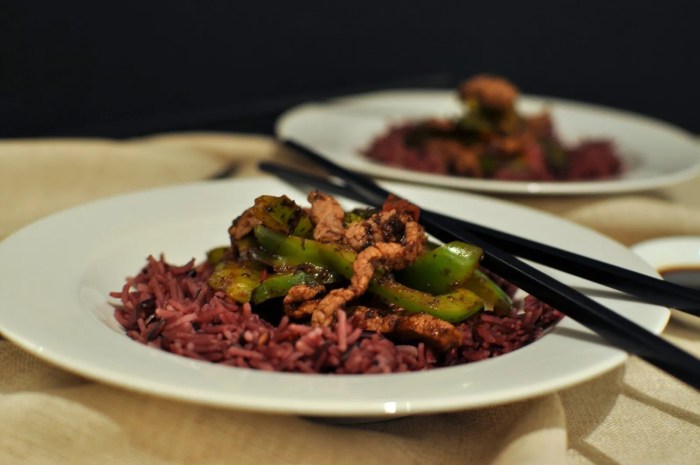
Quick Beef Stir Fry: A Delicious and Easy Weeknight Meal
Quick beef stir fry is a true culinary hero, effortlessly bringing a burst of flavor and satisfaction to any weeknight dinner. It’s a dish that dances between convenience and complexity, allowing you to whip up a delicious meal in a matter of minutes without sacrificing taste.
The possibilities are endless, with the ability to customize the ingredients and sauces to suit your preferences and dietary needs. Whether you’re craving a hearty and satisfying meal or a light and healthy option, quick beef stir fry has you covered.
The beauty of this dish lies in its versatility. You can easily adapt it to different tastes and dietary needs by using alternative protein sources like chicken or tofu, incorporating a variety of vegetables, and experimenting with different sauces. The key is to embrace the flexibility and let your creativity shine.
This dish is perfect for busy weeknights when you want a delicious and satisfying meal without spending hours in the kitchen.
Quick Beef Stir Fry: A Delicious and Convenient Meal
Craving a flavorful and satisfying meal that’s ready in minutes? Look no further than quick beef stir fry! This versatile dish offers a perfect blend of convenience, taste, and nutritional value, making it a go-to choice for busy weeknights or impromptu gatherings.
Quick beef stir fry is a culinary chameleon, adapting to your preferences and dietary needs. Whether you’re a seasoned chef or a kitchen novice, this dish is incredibly easy to prepare, requiring minimal ingredients and cooking time. The key lies in using fresh, high-quality ingredients and mastering the art of stir-frying, which allows you to create a symphony of flavors in a matter of minutes.
Versatility of Quick Beef Stir Fry
The beauty of quick beef stir fry lies in its adaptability. It can be customized to suit various tastes and dietary preferences. Here are a few examples:
- Spice it up:Add a dash of chili flakes, sriracha, or a fiery pepper for a kick of heat.
- Go vegetarian:Substitute the beef with tofu, tempeh, or seitan for a plant-based option.
- Get creative with vegetables:Explore different combinations of vegetables, such as broccoli, carrots, snap peas, bell peppers, or mushrooms.
- Experiment with sauces:Try different sauces like teriyaki, oyster sauce, or hoisin for a unique flavor profile.
Ingredients: Quick Beef Stir Fry

A quick beef stir fry is a versatile dish that allows for a variety of ingredients based on your preferences and dietary needs. While the main components are protein, vegetables, and sauce, there are many options to customize your meal.The key is to choose ingredients that cook quickly and complement each other in terms of flavor and texture.
This section explores essential ingredients, alternative options, and nutritional information to guide you in creating your own quick beef stir fry.
Quick beef stir fry is a great weeknight meal, especially when you’re short on time. The key to a successful stir fry is all about getting those veggies perfectly crisp and tender. And while I’m on the topic of quick and easy meals, you have to check out this recipe for stuffed air fryer potatoes ! They’re a perfect side dish for any stir fry, and they’re incredibly easy to make.
Back to the stir fry, be sure to season generously with soy sauce, garlic, and ginger. It’s the perfect way to bring out the flavors of the beef and vegetables.
Essential Ingredients
The essential ingredients for a quick beef stir fry include:
- Protein: Beef is the traditional protein source, but you can easily substitute it with chicken, tofu, or even shrimp for a different flavor profile.
- Vegetables: Common vegetables for stir-fry include broccoli, peppers (bell peppers, chili peppers), onions, carrots, and snap peas.
These vegetables cook quickly and add color, texture, and nutritional value to the dish.
- Sauce: The sauce is the key to bringing all the flavors together. A simple combination of soy sauce, oyster sauce, and hoisin sauce creates a savory and slightly sweet base.
Quick beef stir fry is a great weeknight meal, especially when you want something fast and flavorful. But sometimes, I crave something a little more slow-cooked and smoky, like the delicious bobs pulled pork on a smoker recipe I found.
The smoky aroma and tender meat are irresistible. However, when I’m short on time, the quick and easy stir fry always hits the spot.
You can also add a touch of ginger, garlic, and sesame oil for additional depth of flavor.
Alternative Ingredient Options
For those with dietary restrictions or preferences, there are several alternative ingredient options:
- Protein: If you are vegetarian or vegan, tofu is an excellent protein source. You can also use tempeh, seitan, or mushrooms.
- Vegetables: If you prefer a milder flavor, use vegetables like zucchini, mushrooms, or bok choy. You can also add a variety of greens like spinach or kale.
- Sauce: For a lighter sauce, you can use less soy sauce or substitute it with tamari. You can also use a cornstarch slurry to thicken the sauce instead of relying on sugar.
Nutritional Value and Substitutions
Here is a table outlining common ingredients, their nutritional value, and potential substitutions:
| Ingredient | Nutritional Value | Potential Substitutions |
|---|---|---|
| Beef | High in protein, iron, and zinc | Chicken, tofu, shrimp, pork |
| Broccoli | Rich in vitamin C, vitamin K, and fiber | Cauliflower, Brussels sprouts, asparagus |
| Bell Peppers | Source of vitamin C, vitamin A, and antioxidants | Chili peppers, jalapenos, poblano peppers |
| Onions | Good source of vitamin C, potassium, and fiber | Shallots, garlic, leeks |
| Soy Sauce | Provides umami flavor and sodium | Tamari, coconut aminos |
| Oyster Sauce | Adds a savory and slightly sweet flavor | Fish sauce, hoisin sauce |
Preparation

The magic of stir-fry lies in the quick cooking and vibrant flavors. Here’s how to prep the ingredients for a delicious and satisfying meal.
Preparing the Beef
The key to tender and flavorful beef is in the marinating and cutting techniques.
- Marinate for Depth of Flavor:A simple marinade of soy sauce, ginger, garlic, and a touch of honey can transform the beef. The marinade tenderizes the meat while adding a burst of umami. For a richer flavor, consider adding a dash of sesame oil or rice wine.
- Thinly Slice for Quick Cooking:Cutting the beef thinly ensures it cooks quickly and evenly. Use a sharp knife to slice against the grain, which creates more tender bites.
- Cook to Perfection:Stir-fry the beef for a short time, just until it’s browned on all sides. Overcooking will make the meat tough.
Preparing the Vegetables
The beauty of stir-fry is the colorful array of vegetables. Here’s how to prep them to retain their freshness and vibrant flavors.
Quick beef stir fry is a staple in my kitchen – it’s so versatile and easy to throw together. I love to serve it with a side of fluffy rice and a touch of sweetness, like candied sweet potatoes with maple syrup.
The sweet and savory combo is a real winner, and the sweet potatoes are a great way to add a healthy dose of vitamins and fiber to the meal.
- Chop into Bite-Sized Pieces:Uniformly chopped vegetables ensure even cooking. Use a sharp knife and a chopping board to cut the vegetables into bite-sized pieces.
- Blanching for Optimal Texture:Blanching vegetables before stir-frying helps preserve their color and crispness. Briefly immerse the vegetables in boiling water for a few seconds, then immediately transfer them to ice water to stop the cooking process.
- Freshness Matters:Choose fresh vegetables for the best flavor. Avoid vegetables that are wilted or have signs of spoilage.
Preparing the Sauce
The sauce is the heart and soul of stir-fry. Here’s how to create a balanced and flavorful sauce that brings everything together.
- Balancing the Flavors:A classic stir-fry sauce typically combines soy sauce for saltiness, sugar for sweetness, and cornstarch for thickening. You can also add a dash of vinegar for tanginess or chili flakes for a touch of heat.
- Adjusting the Consistency:The consistency of the sauce depends on your preference. For a thicker sauce, use more cornstarch. For a thinner sauce, use less cornstarch or add a little water.
- Whisk Until Smooth:Whisk the sauce ingredients together until they are completely combined and smooth. This ensures that the sauce is evenly distributed throughout the stir-fry.
Cooking Techniques

The key to a successful quick beef stir fry lies in the cooking techniques. High heat and rapid cooking are essential for achieving crispy vegetables and tender beef, while maintaining the vibrant flavors of your ingredients.
Stir-Frying Technique
Stir-frying is a quick and efficient cooking method that uses high heat and continuous movement to cook ingredients quickly and evenly. The rapid cooking helps to seal in the juices of the meat and vegetables, resulting in tender beef and crisp vegetables.
Continuous movement prevents sticking and ensures even cooking.
Cooking Methods for Different Ingredients, Quick beef stir fry
- Searing the Beef:Searing the beef is crucial for developing a flavorful crust. This process involves cooking the beef over high heat for a short period, usually 1-2 minutes per side. The high heat creates a flavorful sear, while the short cooking time ensures the beef remains tender and juicy.
- Stir-Frying Vegetables:Vegetables are stir-fried quickly over high heat to preserve their vibrant color and crisp texture. They are typically added to the wok after the beef has been seared, allowing them to cook quickly and evenly.
- Thickening the Sauce:A common technique for thickening stir-fry sauces is to use cornstarch slurry. This is a mixture of cornstarch and water that is added to the sauce towards the end of cooking. The cornstarch thickens the sauce, creating a glossy and flavorful coating for the beef and vegetables.
Serving and Variations
A quick beef stir fry is a versatile dish that can be served in many ways. It is ideal for a quick and satisfying meal, but can also be elevated for a more formal occasion.
Serving Temperatures and Accompaniments
The ideal serving temperature for a quick beef stir fry is hot. This ensures that the flavors are vibrant and the ingredients are cooked to perfection. It can be served with a variety of accompaniments, including:
- Rice: White rice, brown rice, or jasmine rice are all excellent choices for serving with a quick beef stir fry. Rice helps to absorb the delicious sauce and provides a hearty base for the dish.
- Noodles: Stir-fried noodles, such as rice noodles, egg noodles, or ramen noodles, are another great option for serving with a quick beef stir fry. Noodles add a chewy texture and can be tossed with the sauce for an extra burst of flavor.
- Fresh Herbs: A sprinkle of fresh herbs, such as cilantro, basil, or mint, can add a refreshing and aromatic touch to a quick beef stir fry. These herbs complement the savory flavors of the dish and provide a burst of freshness.
Variations and Customizations
Quick beef stir fry is a great base recipe that can be easily customized to suit different tastes and preferences.
- Spices: Experiment with different spices to add depth and complexity to the flavor profile. For a bolder flavor, add chili flakes, black pepper, or cumin. For a more nuanced flavor, try ginger, garlic, or turmeric.
- Sauces: Explore different sauces to create unique flavor combinations. For a sweet and savory flavor, use oyster sauce or hoisin sauce. For a tangy and spicy flavor, use sriracha or gochujang sauce.
- Unique Ingredients: Incorporate different vegetables, proteins, or other ingredients to create your own signature stir fry. Add tofu, shrimp, or chicken for additional protein. Experiment with different vegetables, such as broccoli, bell peppers, or mushrooms, for added texture and flavor.
Quick Beef Stir Fry Variations
Here are some quick beef stir fry variations that you can try:
| Variation | Ingredients | Cooking Method |
|---|---|---|
| Classic Beef Stir Fry | Beef, onion, garlic, soy sauce, ginger, sugar, cornstarch, sesame oil | Stir-fry beef, onion, and garlic in a hot wok or pan. Add soy sauce, ginger, sugar, and cornstarch mixture. Stir-fry until sauce thickens and beef is cooked through. |
| Spicy Beef Stir Fry | Beef, bell peppers, onion, garlic, chili flakes, soy sauce, sriracha sauce, cornstarch, sesame oil | Stir-fry beef, bell peppers, onion, and garlic in a hot wok or pan. Add chili flakes, soy sauce, sriracha sauce, and cornstarch mixture. Stir-fry until sauce thickens and beef is cooked through. |
| Ginger Beef Stir Fry | Beef, ginger, garlic, soy sauce, honey, cornstarch, sesame oil | Stir-fry beef, ginger, and garlic in a hot wok or pan. Add soy sauce, honey, and cornstarch mixture. Stir-fry until sauce thickens and beef is cooked through. |
Tips and Tricks
Mastering the art of quick beef stir fry goes beyond simply following a recipe. It’s about understanding the nuances that elevate your dish from good to exceptional. Here are some key tips and tricks to help you achieve optimal flavor and texture in your stir fry.
Choosing the Right Ingredients
High-quality ingredients are crucial for a flavorful and satisfying stir fry. Opt for tender cuts of beef, such as sirloin, ribeye, or flank steak, and ensure they are properly marinated to enhance their flavor and tenderness. Fresh vegetables are essential for vibrant color and crisp texture.
Consider using a variety of vegetables with different cooking times to create a balanced and visually appealing stir fry.
Cooking Techniques for Optimal Texture
The success of a quick beef stir fry hinges on proper cooking techniques. Start by searing the beef over high heat to achieve a flavorful crust. Then, quickly stir-fry the vegetables, ensuring they remain crisp-tender. Overcrowding the pan can lead to steaming rather than stir-frying, so cook in batches if necessary.
Flavor Enhancement
Enhance the flavor of your stir fry by using a combination of aromatic ingredients. Fresh ginger and garlic are essential for a pungent and savory base. Soy sauce, oyster sauce, and hoisin sauce add umami and depth to the dish.
Don’t be afraid to experiment with different spices and herbs, such as chili flakes, sesame oil, and cilantro.
Troubleshooting Common Issues
Overcooked Vegetables
Overcooked vegetables can become mushy and lose their vibrant color. To prevent this, stir-fry them quickly over high heat. Add vegetables with longer cooking times first, followed by those that cook more quickly.
Dry Beef
Dry beef can be a common problem in stir fry. To prevent this, marinate the beef for at least 30 minutes before cooking. Alternatively, add a small amount of broth or water to the pan during cooking to keep the beef moist.
Repurposing Leftovers and Variations
Leftover Beef Stir Fry
Repurpose leftover stir fry by adding it to rice bowls, salads, or wraps. You can also use it as a filling for dumplings or spring rolls.
Variations
Experiment with different protein sources, such as chicken, shrimp, or tofu. Add different vegetables, such as mushrooms, broccoli, or bell peppers. Try different sauces, such as teriyaki, peanut sauce, or sweet chili sauce.






